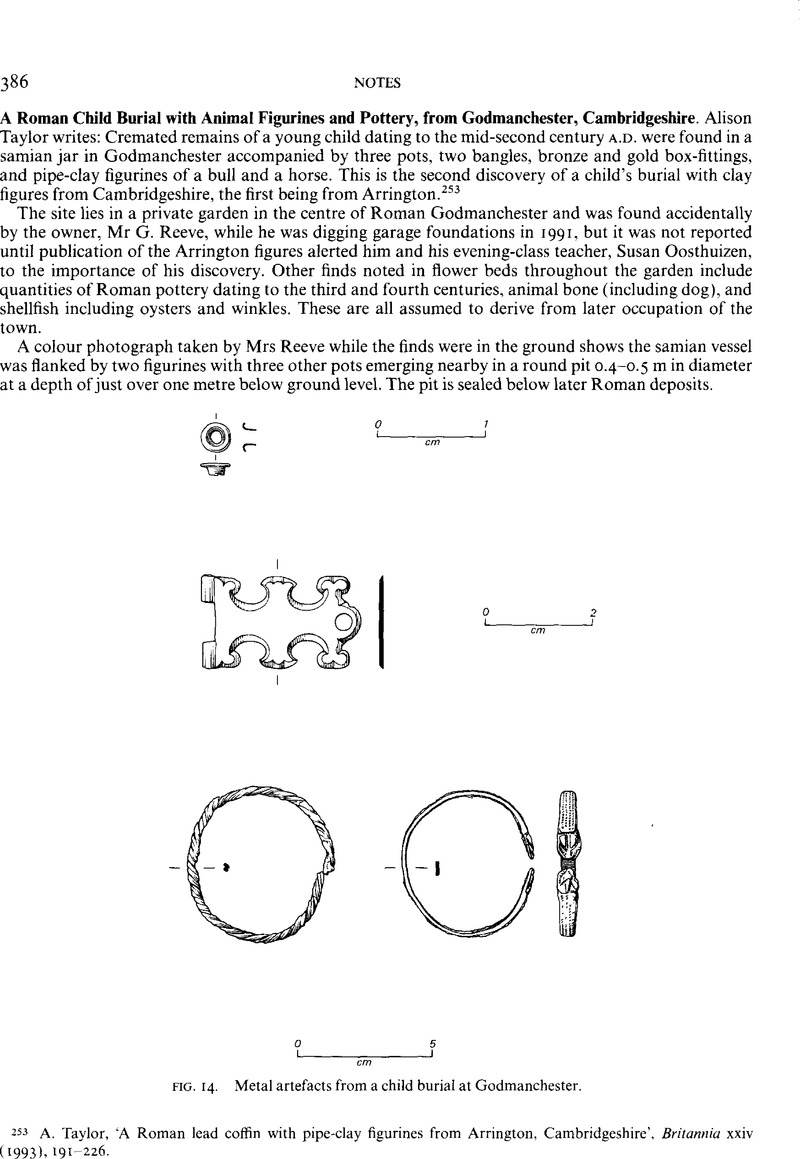Article contents
A Roman Child Burial with Animal Figurines and Pottery, from Godmanchester, Cambridgeshire
Published online by Cambridge University Press: 09 November 2011
Abstract

- Type
- Notes
- Information
- Copyright
- Copyright © Alison Taylor 1997. Exclusive Licence to Publish: The Society for the Promotion of Roman Studies
References
253 Taylor, A., ‘A Roman lead coffin with pipe-clay figurines from Arrington, Cambridgeshire’, Britannia xxiv (1993), 191–226.CrossRefGoogle Scholar
254 Pers. comm. Christine Jones, Colchester & Essex Museum, July 1993.
255 M. Rouvier-Jeanlin, Les figurines gallo-romaines en terre-cuite au Musée des Antiquités Nationales, XXIVe supplément à Gallia (1972), no. 1028.
256 M.J. Green, The Religions of Civilian Roman Britain, BAR Brit. Ser. 24 (1976), 217, pl. xixa, b; M.J. Green, The Gods of the Celts (1986), 191, fig. 84.
257 M.J. Green, Symbol and Image in Celtic Religious Art (1989), 181, fig. 82.
258 Rouvier-Jeanlin, op. cit. (note 255), Type 1, Groupe C, no. 976.
259 Green, op. cit. (note 256), 231, pl. xxie; Jenkins, F., ‘The horse-deity of Roman Canterbury’, Arch. Cant., lxxvii (1962), 142ff.Google Scholar
260 Green, op. cit (note 256), 164, pl. xxig.
261 ibid., 211, pl. iie.
262 F. Jenkins, ‘Some interesting types of clay statuettes of the Roman period found in London’, in J. Bird et al. (eds), Collectanea Londinensia (1978), 149–62.
263 M.J. Green, Animals in Celtic Life and Myth (1992), 204-10.
264 ibid., 220-4, esp. 223, fig. 8.21.
265 ibid., 234-8.
266 J.-L. Brunaux, The Celtic Gauls: Gods, Rites and Sanctuaries (1988); P. Meniel, Chasse et elèvage chez les Gaulois (1987).
267 M.J. Green, Dictionary of Celtic Myth and Legend (1992), 51-2; T. Kinsella, The Tain (1969).
268 Green, op. cit. (note 263), 66-91.
269 T.P. Pick and R. Howden (eds), Gray's Anatomy (Anatomy, descriptive and surgical) (American ed. from 15th Englished., 1988).
270 Walker, F.G., ‘Greek coins and Syrian arrowheads dug up in a Roman cemetery in Godmanchester’, Proc. Camb. Ant. Soc. xiii (1909), 282–90.Google Scholar
271 H.J.M. Green, ‘Roman Godmanchester’, in W. Rodwell and T. Rowley (eds), Small Towns in Roman Britain, BAR 15 (1975), 183-210.
272 Rankov, N.B., ‘Roman Britain in 1981’, Britannia xiii (1982), 363.Google Scholar
273 G.T. Rudd, pers. comm, and the author's observations.
274 L. Hoyland and G. Wait, Roman Burials at London Street, Godmanchester (1992).
275 T. Reynolds, Roman Burials and Settlement Remains at The Parks, Godmanchester (1992).
276 R.A. Philpott, Burial Practices in Roman Britain, BAR 219 (1991).
277 F. McAvoy (interim report), Godmanchester, Rectory Farm (1990).
278 M.J. Green in Taylor, op. cit. (note 253), 212-25.
279 Green, op. cit. (note 271), 196.
280 ibid.
281 S. Esmonde Cleary, ‘Town and country in Roman Britain?’ in S. Bassett (ed.), Death in Towns (1992), 32.
- 3
- Cited by




